engine SUZUKI ALTO 2014 User Guide
[x] Cancel search | Manufacturer: SUZUKI, Model Year: 2014, Model line: ALTO, Model: SUZUKI ALTO 2014Pages: 139, PDF Size: 2.22 MB
Page 42 of 139
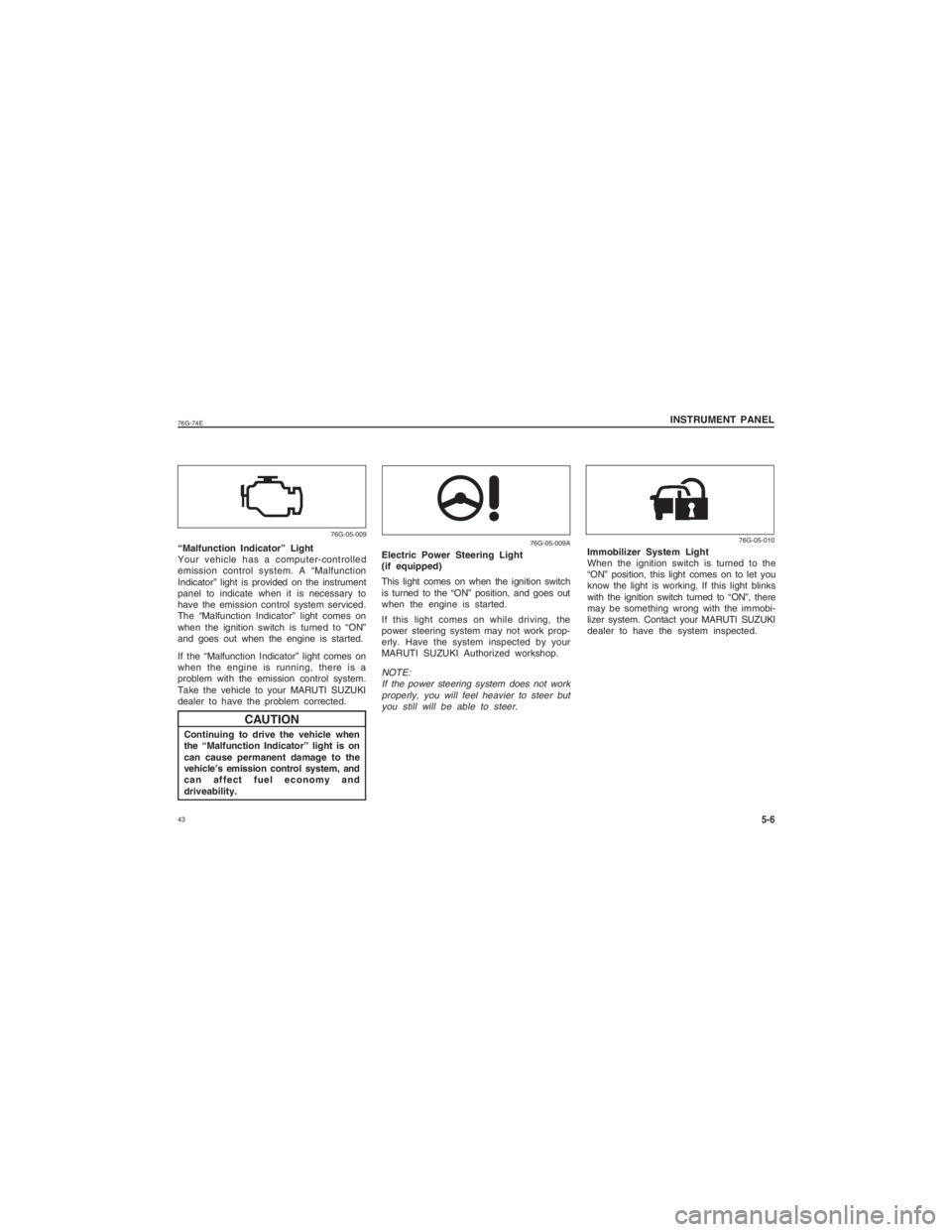
4376G-74E
INSTRUMENT PANEL
5-6
Immobilizer System Light
When the ignition switch is turned to the
“ON” position, this light comes on to let you
know the light is working. If this light blinks
with the ignition switch turned to “ON”, there
may be something wrong with the immobi-
lizer system. Contact your MARUTI SUZUKI
dealer to have the system inspected.
76G-05-010
Electric Power Steering Light
(if equipped)
This light comes on when the ignition switch
is turned to the “ON” position, and goes out
when the engine is started.
If this light comes on while driving, the
power steering system may not work prop-
erly. Have the system inspected by your
MARUTI SUZUKI Authorized workshop.NOTE:If the power steering system does not workproperly, you will feel heavier to steer butyou still will be able to steer.
76G-05-009A
“Malfunction Indicator” Light
Your vehicle has a computer-controlled
emission control system. A “Malfunction
Indicator” light is provided on the instrument
panel to indicate when it is necessary to
have the emission control system serviced.
The “Malfunction Indicator” light comes on
when the ignition switch is turned to “ON”
and goes out when the engine is started.
If the “Malfunction Indicator” light comes on
when the engine is running, there is a
problem with the emission control system.
Take the vehicle to your MARUTI SUZUKI
dealer to have the problem corrected.
Continuing to drive the vehicle when
the “Malfunction Indicator” light is on
can cause permanent damage to the
vehicle’s emission control system, and
can affect fuel economy and
driveability.
CAUTION
76G-05-009
Page 45 of 139

46
76G-74E
INSTRUMENT PANEL5-9
HIGH ENGINE COOLANT
TEMPERATURE WARNING
LIGHT (Red Color)When the ignition switch is turned to the
“ON” position, this light comes on briefly so
you can check that the light is working. If
this light blinks while driving, it means the
engine is running hot. Avoid driving condi-
tions that may lead to actual overheating.
If the light stays on without blinking, then
the engine is overheating. Follow the in-
structions in the “If the Engine Over heats”
of “EMERGENCY SERVICE” section.Continuing to drive the vehicle when
engine overheating is indicated can
result in severe engine damage.
CAUTION
76G-05-019
FUEL GAUGEWhen the ignition switch is in the “ON”
position, this gauge gives an approximate
indication of the amount of fuel in the fuel
tank. “F” stands for full and “E” stands for
empty.
When the fuel meter indicator shows only
one segment to “E”, refill the tank as soon
as possible.Note:If the last segment blinks, it means that the
fuel tank is almost empty.
Note:The fuel level indicator varies depending onroad conditions (for example, slope orcurve) and driving conditions because of
fuel moving in the tank.
76G-05-018
The tachometer indicates engine speed
in revolutions per minute.
76G-05-013C
Never drive with the engine speed in-
dicator in the red zone (1) or severe
engine damage can result.
When downshifting to a lower gear,
make sure not to operate with exces-
sive revolution speeds of the engine.
Refer to “Downshifting maximum allow-
able speeds” in the “OPERATING
YOUR VEHICLE” section.
CAUTION
TACHOMETER (if equipped)
Page 53 of 139
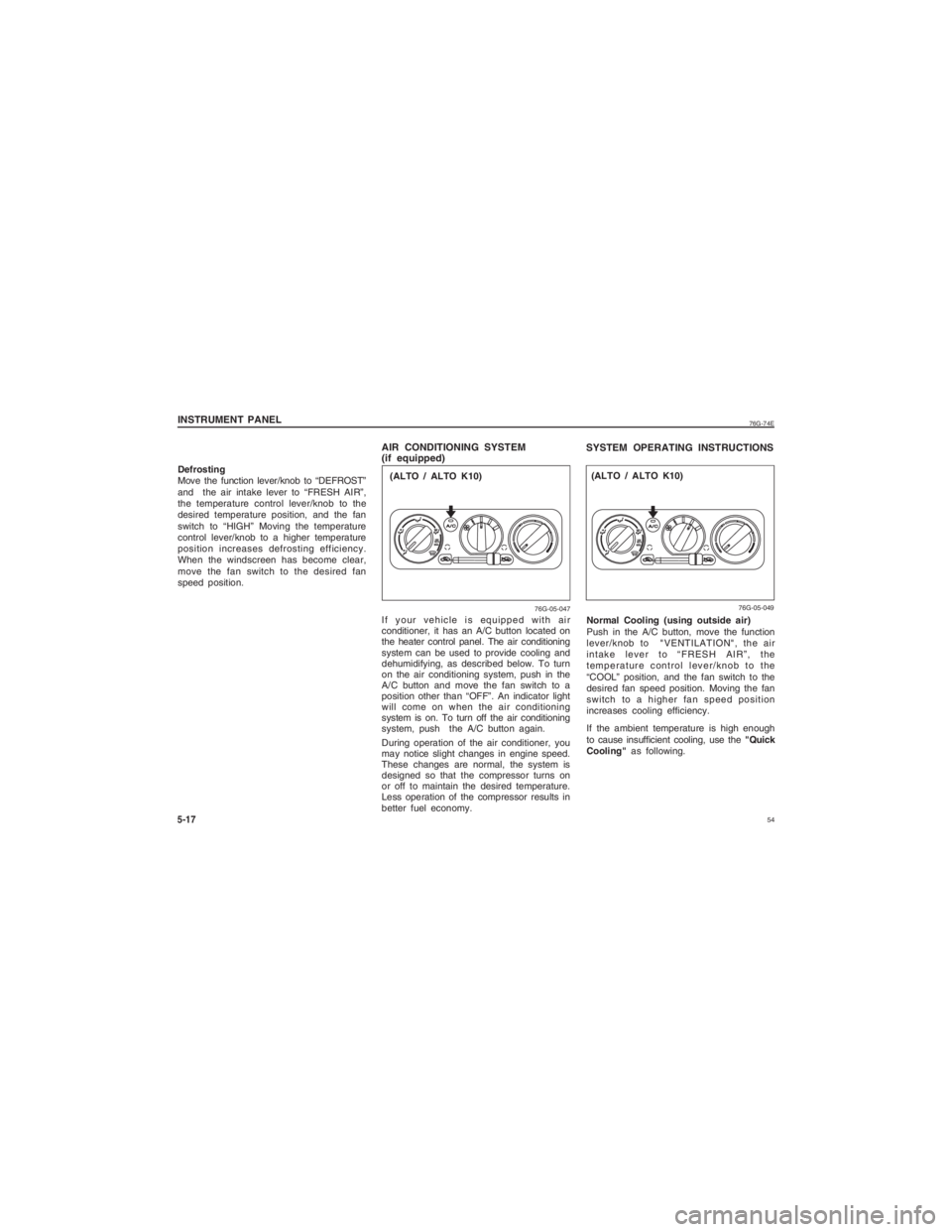
54
76G-74E
Defrosting
Move the function lever/knob to “DEFROST”
and the air intake lever to “FRESH AIR”,
the temperature control lever/knob to the
desired temperature position, and the fan
switch to “HIGH” Moving the temperature
control lever/knob to a higher temperature
position increases defrosting efficiency.
When the windscreen has become clear,
move the fan switch to the desired fan
speed position.
AIR CONDITIONING SYSTEM
(if equipped)If your vehicle is equipped with air
conditioner, it has an A/C button located on
the heater control panel. The air conditioning
system can be used to provide cooling and
dehumidifying, as described below. To turn
on the air conditioning system, push in the
A/C button and move the fan switch to a
position other than “OFF”. An indicator light
will come on when the air conditioning
system is on. To turn off the air conditioning
system, push the A/C button again.
During operation of the air conditioner, you
may notice slight changes in engine speed.
These changes are normal, the system is
designed so that the compressor turns on
or off to maintain the desired temperature.
Less operation of the compressor results in
better fuel economy.
5-17INSTRUMENT PANEL
76G-05-047
(ALTO / ALTO K10)
SYSTEM OPERATING INSTRUCTIONSNormal Cooling (using outside air)
Push in the A/C button, move the function
lever/knob to "VENTILATION", the air
intake lever to “FRESH AIR”, the
temperature control lever/knob to the
“COOL” position, and the fan switch to the
desired fan speed position. Moving the fan
switch to a higher fan speed position
increases cooling efficiency.
If the ambient temperature is high enough
to cause insufficient cooling, use the "Quick
Cooling" as following.
76G-05-049
(ALTO / ALTO K10)
Page 54 of 139
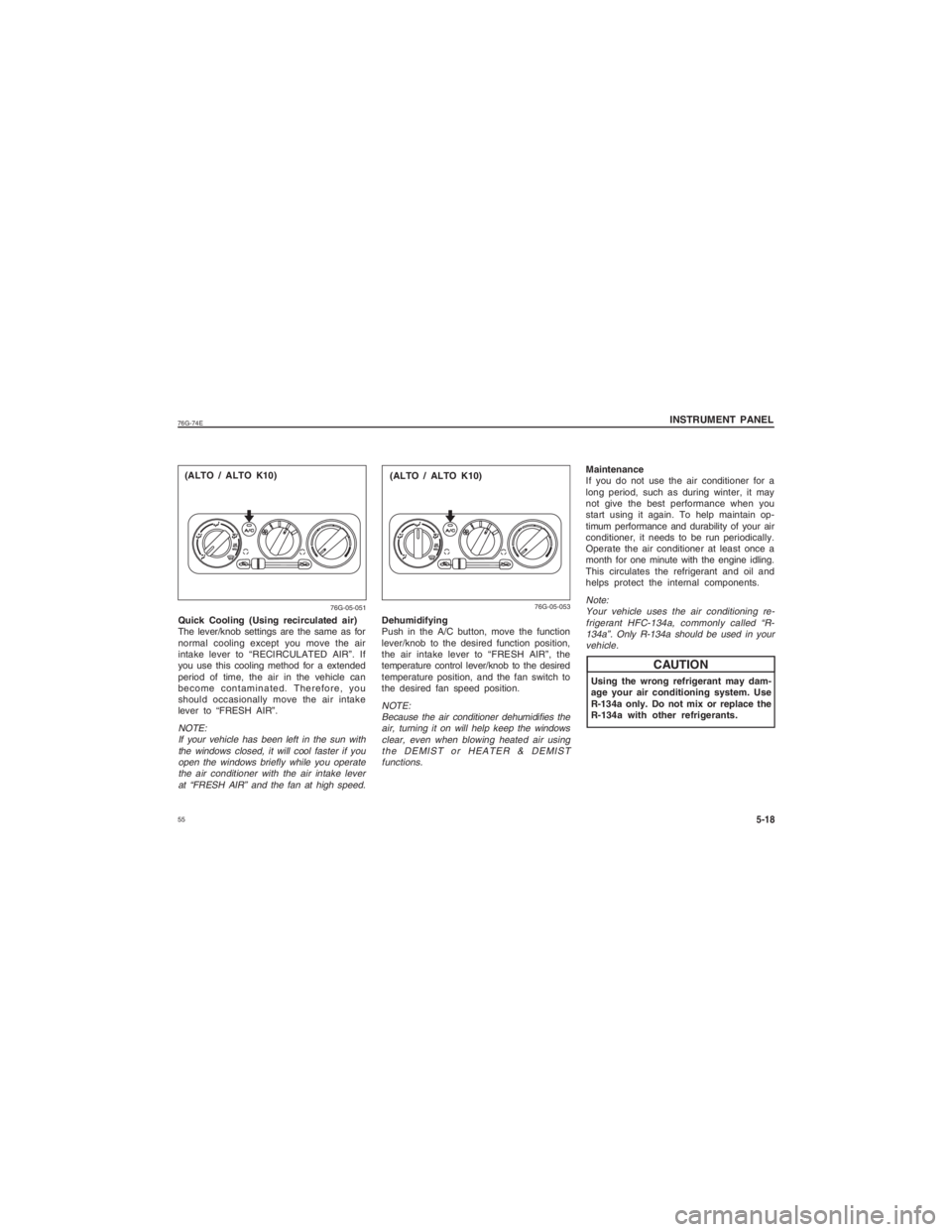
5576G-74E
INSTRUMENT PANEL
5-18
76G-05-051
(ALTO / ALTO K10)
Quick Cooling (Using recirculated air)
The lever/knob settings are the same as for
normal cooling except you move the air
intake lever to “RECIRCULATED AIR”. If
you use this cooling method for a extended
period of time, the air in the vehicle can
become contaminated. Therefore, you
should occasionally move the air intake
lever to “FRESH AIR”.NOTE: If your vehicle has been left in the sun with
the windows closed, it will cool faster if youopen the windows briefly while you operatethe air conditioner with the air intake leverat “FRESH AIR” and the fan at high speed.
Dehumidifying
Push in the A/C button, move the function
lever/knob to the desired function position,
the air intake lever to “FRESH AIR”, the
temperature control lever/knob to the desired
temperature position, and the fan switch to
the desired fan speed position.NOTE:
Because the air conditioner dehumidifies theair, turning it on will help keep the windowsclear, even when blowing heated air using
the DEMIST or HEATER & DEMISTfunctions.
76G-05-053
(ALTO / ALTO K10) Maintenance
If you do not use the air conditioner for a
long period, such as during winter, it may
not give the best performance when you
start using it again. To help maintain op-
timum performance and durability of your air
conditioner, it needs to be run periodically.
Operate the air conditioner at least once a
month for one minute with the engine idling.
This circulates the refrigerant and oil and
helps protect the internal components.
Note:
Your vehicle uses the air conditioning re-frigerant HFC-134a, commonly called “R-134a”. Only R-134a should be used in your
vehicle.
CAUTION
Using the wrong refrigerant may dam-
age your air conditioning system. Use
R-134a only. Do not mix or replace the
R-134a with other refrigerants.
Page 58 of 139
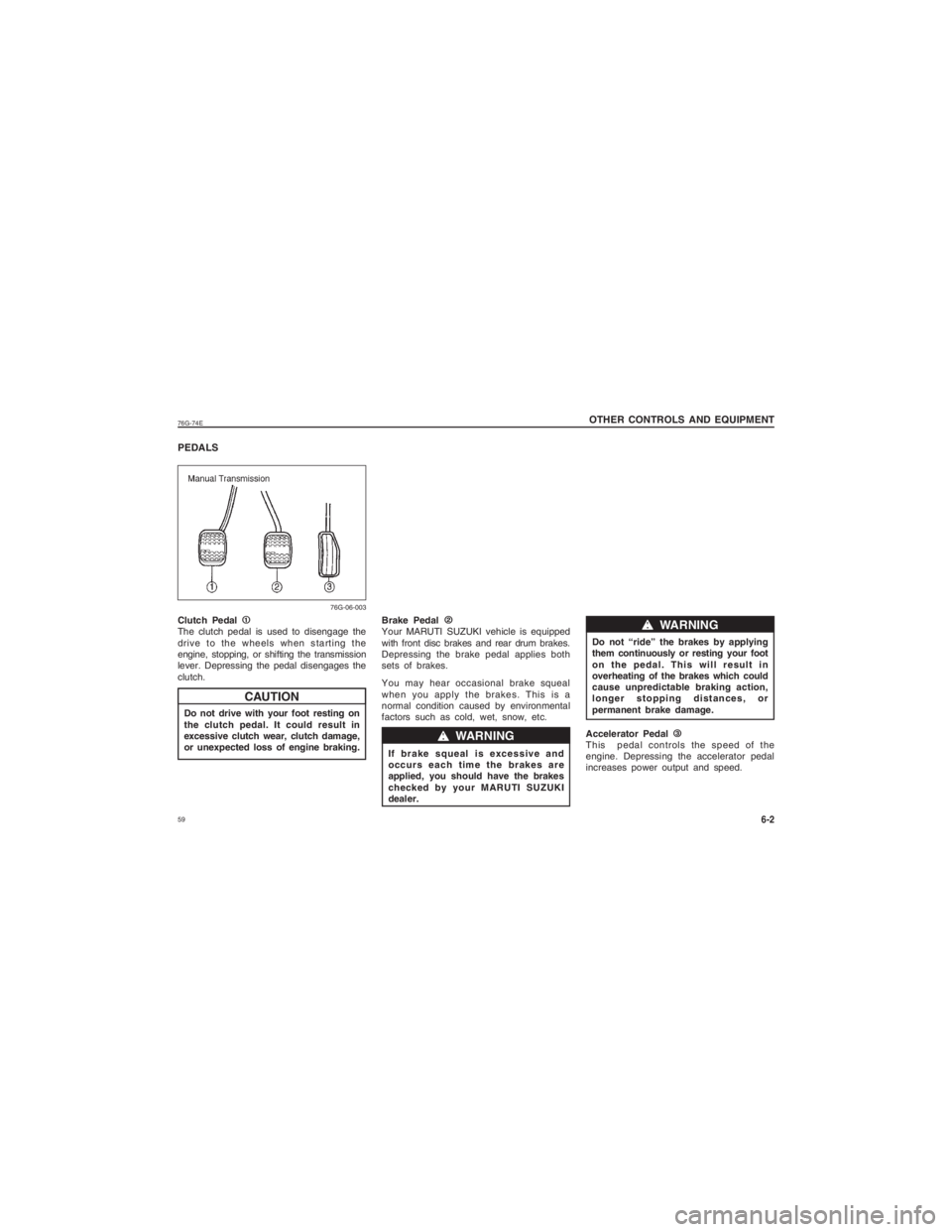
5976G-74EPEDALS
6-2
Clutch Pedal 11 11
1
The clutch pedal is used to disengage the
drive to the wheels when starting the
engine, stopping, or shifting the transmission
lever. Depressing the pedal disengages the
clutch.
Do not drive with your foot resting on
the clutch pedal. It could result in
excessive clutch wear, clutch damage,
or unexpected loss of engine braking. Brake Pedal
22 22
2
Your MARUTI SUZUKI vehicle is equipped
with front disc brakes and rear drum brakes.
Depressing the brake pedal applies both
sets of brakes.
You may hear occasional brake squeal
when you apply the brakes. This is a
normal condition caused by environmental
factors such as cold, wet, snow, etc.
If brake squeal is excessive and
occurs each time the brakes are
applied, you should have the brakes
checked by your MARUTI SUZUKI
dealer.
ww ww
w WARNING
CAUTION
ww
ww
w WARNING
OTHER CONTROLS AND EQUIPMENTDo not “ride” the brakes by applying
them continuously or resting your foot
on the pedal. This will result in
overheating of the brakes which could
cause unpredictable braking action,
longer stopping distances, or
permanent brake damage.
Accelerator Pedal 33 33
3
This pedal controls the speed of the
engine. Depressing the accelerator pedal
increases power output and speed.
76G-06-003
Page 68 of 139
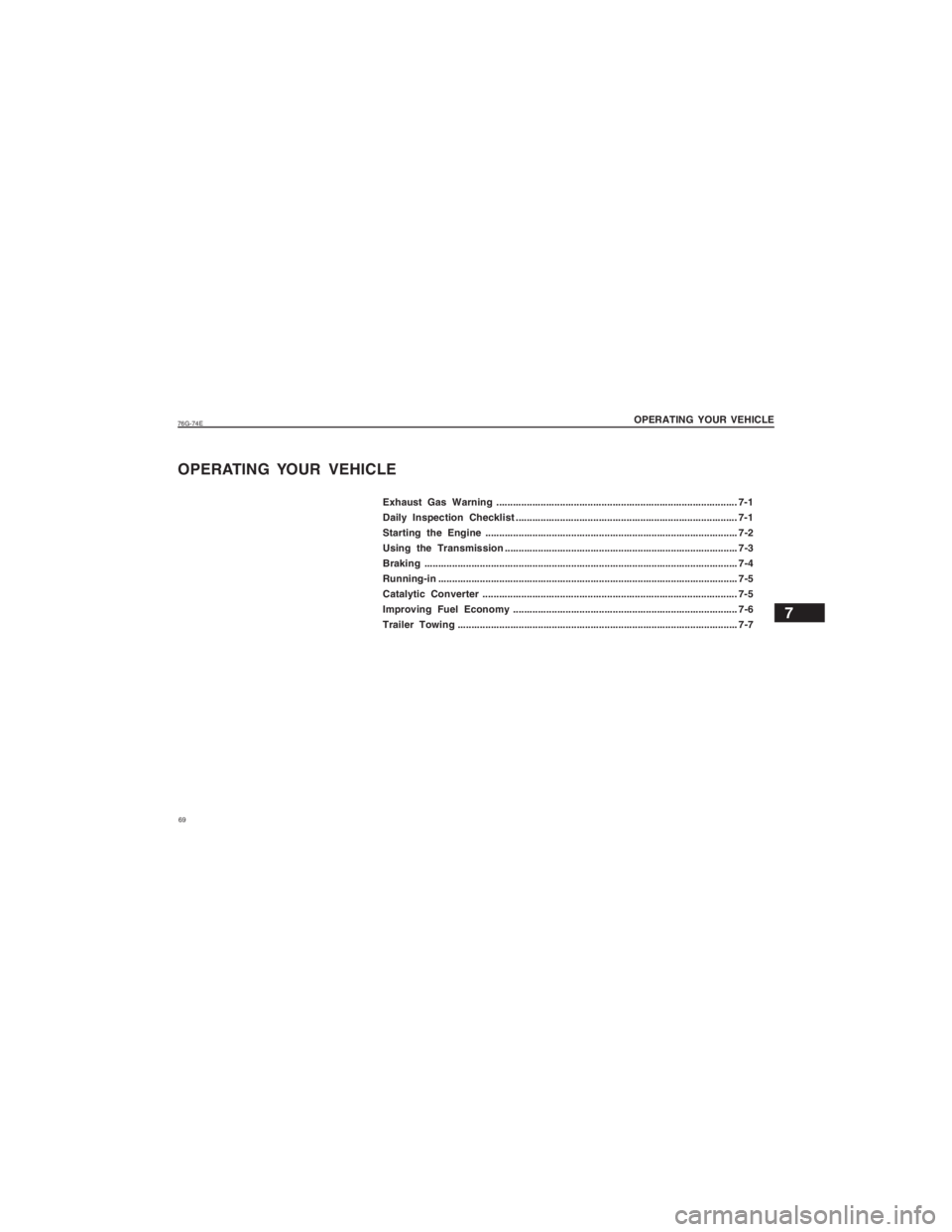
6976G-74E
OPERATING YOUR VEHICLE
7
OPERATING YOUR VEHICLE
Exhaust Gas Warning
........................................................................\
............... 7-1
Daily Inspection Checklist ........................................................................\
........ 7-1
Starting the Engine ........................................................................\
................... 7-2
Using the Transmission ........................................................................\
............ 7-3
Braking ........................................................................\
......................................... 7-4
Running-in ........................................................................\
.................................... 7-5
Catalytic Converter ........................................................................\
.................... 7-5
Improving Fuel Economy ........................................................................\
......... 7-6
Trailer Towing ........................................................................\
............................. 7-7
Page 69 of 139
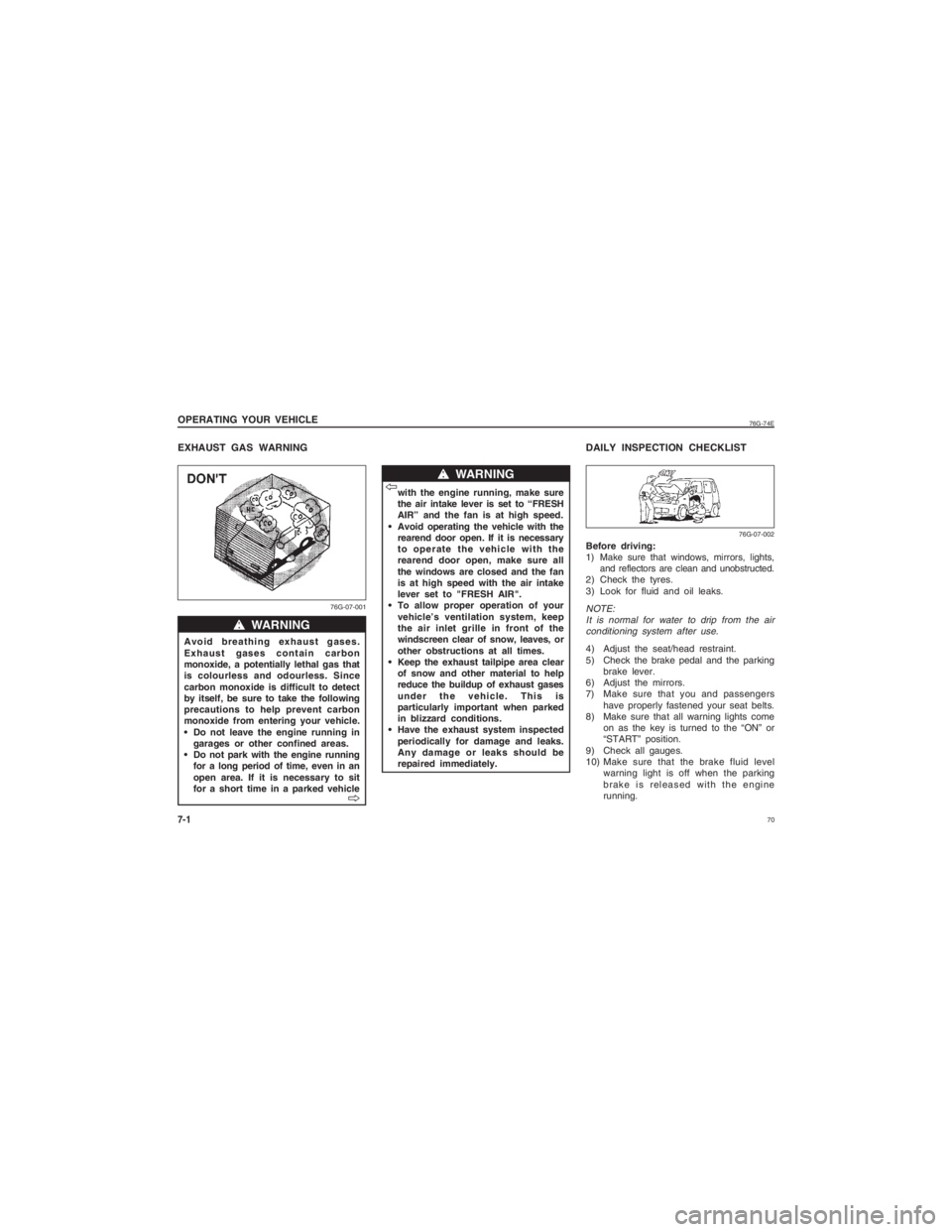
70
76G-74E
EXHAUST GAS WARNING
with the engine running, make sure
the air intake lever is set to “FRESH
AIR” and the fan is at high speed.
Avoid operating the vehicle with the rearend door open. If it is necessary
to operate the vehicle with the
rearend door open, make sure all
the windows are closed and the fan
is at high speed with the air intake
lever set to "FRESH AIR".
To allow proper operation of your vehicle’s ventilation system, keep
the air inlet grille in front of the
windscreen clear of snow, leaves, or
other obstructions at all times.
Keep the exhaust tailpipe area clear of snow and other material to help
reduce the buildup of exhaust gases
under the vehicle. This is
particularly important when parked
in blizzard conditions.
Have the exhaust system inspected
periodically for damage and leaks.
Any damage or leaks should be
repaired immediately.
DAILY INSPECTION CHECKLIST
ww ww
w WARNING
7-1
ww
ww
w WARNING
Before driving:
1)
Make sure that windows, mirrors, lights,
and reflectors are clean and unobstructed.
2) Check the tyres.
3) Look for fluid and oil leaks.NOTE:
It is normal for water to drip from the air
conditioning system after use.4) Adjust the seat/head restraint.
5) Check the brake pedal and the parking brake lever.
6) Adjust the mirrors.
7) Make sure that you and passengers have properly fastened your seat belts.
8) Make sure that all warning lights come on as the key is turned to the “ON” or
“START” position.
9) Check all gauges.
10) Make sure that the brake fluid level warning light is off when the parking
brake is released with the engine
running.
OPERATING YOUR VEHICLEAvoid breathing exhaust gases.
Exhaust gases contain carbon
monoxide, a potentially lethal gas that
is colourless and odourless. Since
carbon monoxide is difficult to detect
by itself, be sure to take the following
precautions to help prevent carbon
monoxide from entering your vehicle.
Do not leave the engine running ingarages or other confined areas.
Do not park with the engine running for a long period of time, even in an
open area. If it is necessary to sit
for a short time in a parked vehicle
VV VV
V
VV
VV
V
76G-07-001 76G-07-002
Page 70 of 139
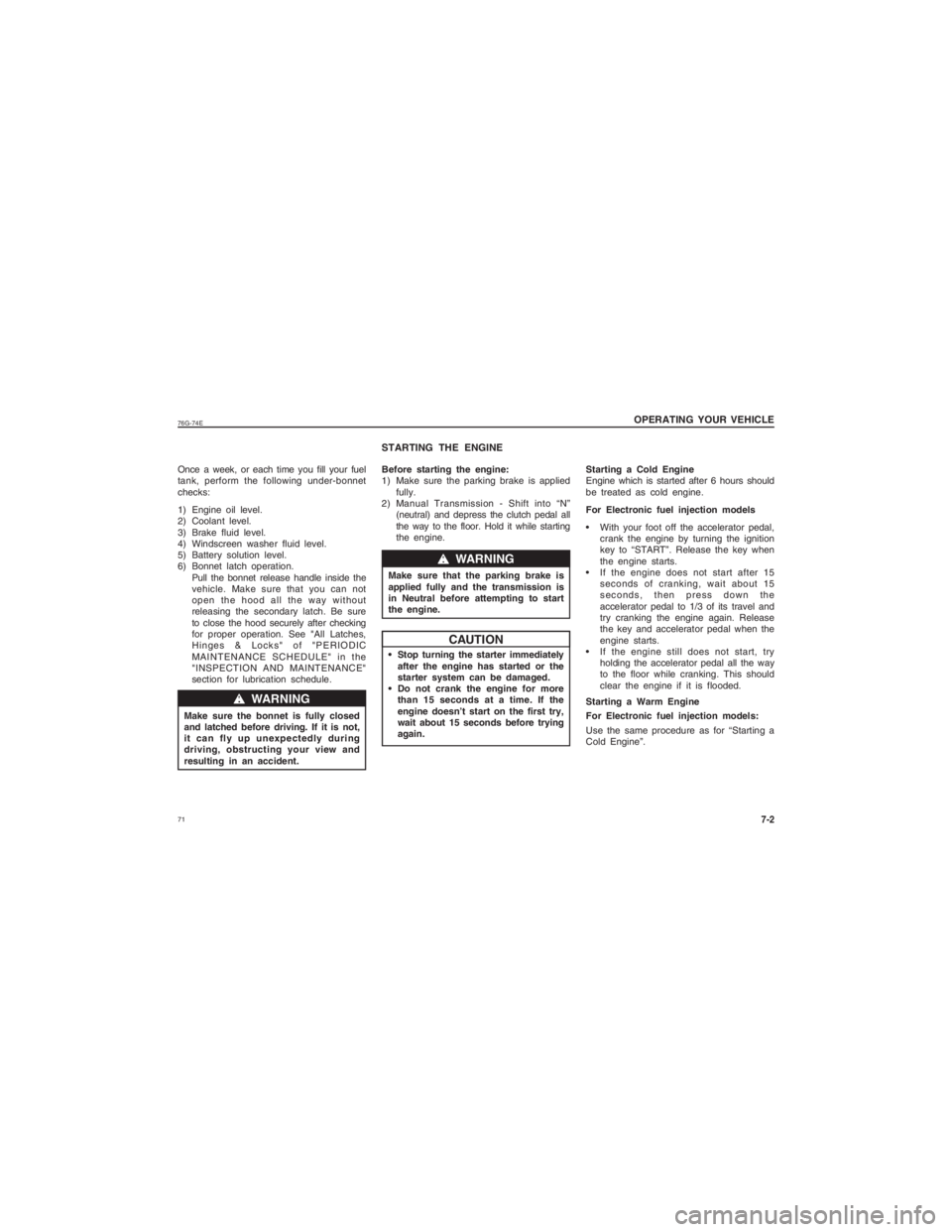
7176G-74E
Before starting the engine:
1) Make sure the parking brake is appliedfully.
2) Manual Transmission - Shift into “N” (neutral) and depress the clutch pedal all
the way to the floor. Hold it while starting
the engine.
Make sure that the parking brake is
applied fully and the transmission is
in Neutral before attempting to start
the engine.
Stop turning the starter immediately after the engine has started or the
starter system can be damaged.
Do not crank the engine for more than 15 seconds at a time. If the
engine doesn’t start on the first try,
wait about 15 seconds before trying
again.
7-2
STARTING THE ENGINE
ww ww
w WARNING
OPERATING YOUR VEHICLE
Once a week, or each time you fill your fuel
tank, perform the following under-bonnet
checks:
1) Engine oil level.
2) Coolant level.
3) Brake fluid level.
4) Windscreen washer fluid level.
5) Battery solution level.
6) Bonnet latch operation.
Pull the bonnet release handle inside the
vehicle. Make sure that you can not
open the hood all the way without
releasing the secondary latch. Be sure
to close the hood securely after checking
for proper operation. See "All Latches,
Hinges & Locks" of "PERIODIC
MAINTENANCE SCHEDULE" in the
"INSPECTION AND MAINTENANCE"
section for lubrication schedule.
Make sure the bonnet is fully closed
and latched before driving. If it is not,
it can fly up unexpectedly during
driving, obstructing your view and
resulting in an accident.
ww ww
w WARNING
Starting a Cold Engine
Engine which is started after 6 hours should
be treated as cold engine.
For Electronic fuel injection models
With your foot off the accelerator pedal,
crank the engine by turning the ignition
key to “START”. Release the key when
the engine starts.
If the engine does not start after 15 seconds of cranking, wait about 15
seconds, then press down the
accelerator pedal to 1/3 of its travel and
try cranking the engine again. Release
the key and accelerator pedal when the
engine starts.
If the engine still does not start, try holding the accelerator pedal all the way
to the floor while cranking. This should
clear the engine if it is flooded.
Starting a Warm Engine
For Electronic fuel injection models:
Use the same procedure as for “Starting a
Cold Engine”.
CAUTION
Page 71 of 139
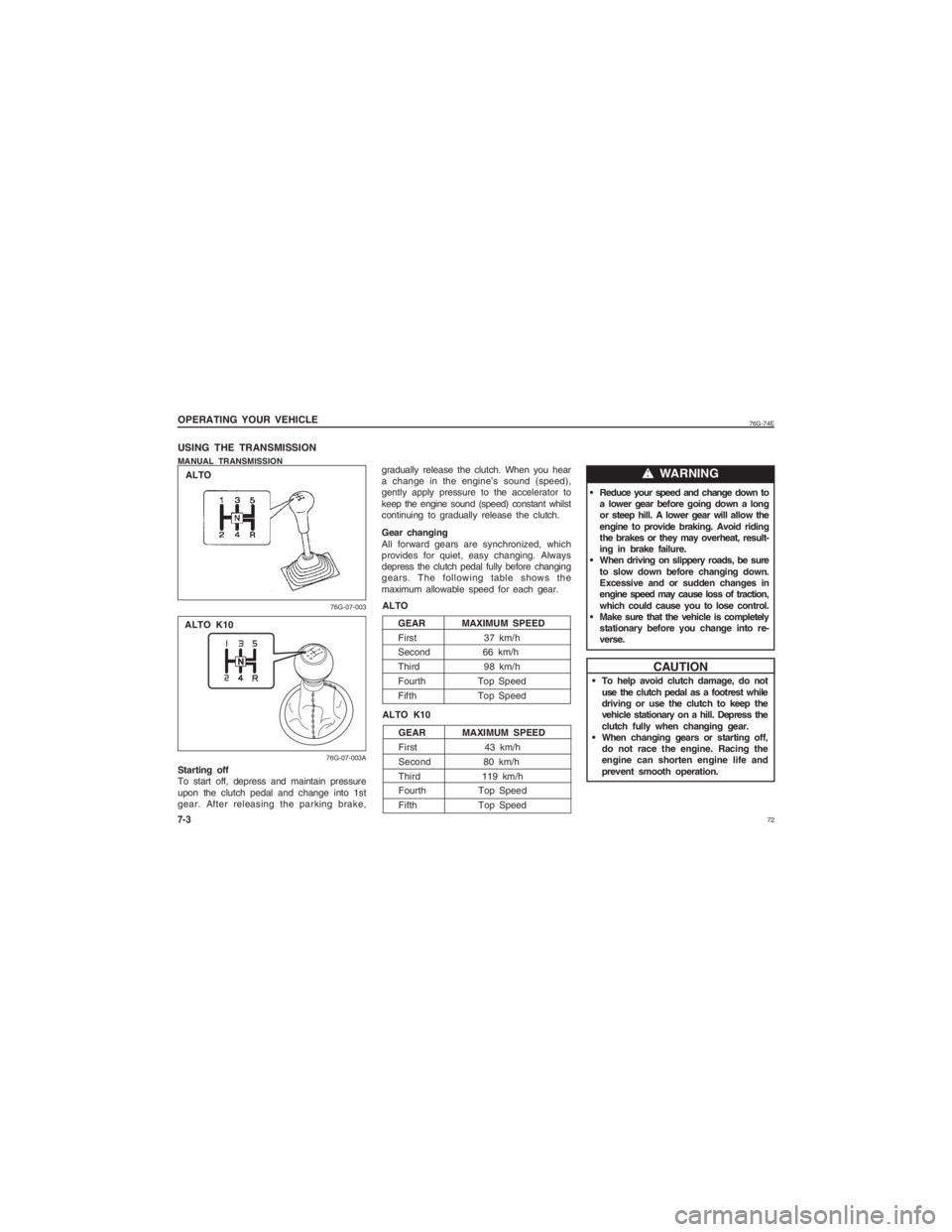
72
76G-74E
7-3OPERATING YOUR VEHICLE
ww ww
w WARNINGCAUTION
Starting off
To start off, depress and maintain pressure
upon the clutch pedal and change into 1st
gear. After releasing the parking brake, GEAR MAXIMUM SPEED
First 37 km/h
Second 66 km/h
Third 98 km/h
Fourth Top Speed
Fifth
Top SpeedUSING THE TRANSMISSIONMANUAL TRANSMISSION
76G-07-00376G-07-003A
To help avoid clutch damage, do not
use the clutch pedal as a footrest while
driving or use the clutch to keep the
vehicle stationary on a hill. Depress the
clutch fully when changing gear.
When changing gears or starting off,
do not race the engine. Racing the
engine can shorten engine life and
prevent smooth operation.
Reduce your speed and change down to
a lower gear before going down a long
or steep hill. A lower gear will allow the
engine to provide braking. Avoid riding
the brakes or they may overheat, result-
ing in brake failure.
When driving on slippery roads, be sure to slow down before changing down.
Excessive and or sudden changes in
engine speed may cause loss of traction,
which could cause you to lose control.
Make sure that the vehicle is completely
stationary before you change into re-
verse.
gradually release the clutch. When you hear
a change in the engine’s sound (speed),
gently apply pressure to the accelerator to
keep the engine sound (speed) constant whilst
continuing to gradually release the clutch.
Gear changing
All forward gears are synchronized, which
provides for quiet, easy changing. Always
depress the clutch pedal fully before changing
gears. The following table shows the
maximum allowable speed for each gear.
ALTO
ALTO K10
GEAR MAXIMUM SPEED
First 43 km/h
Second 80 km/h
Third 119 km/h
Fourth Top Speed
Fifth Top Speed
ALTO
ALTO K10
Page 72 of 139
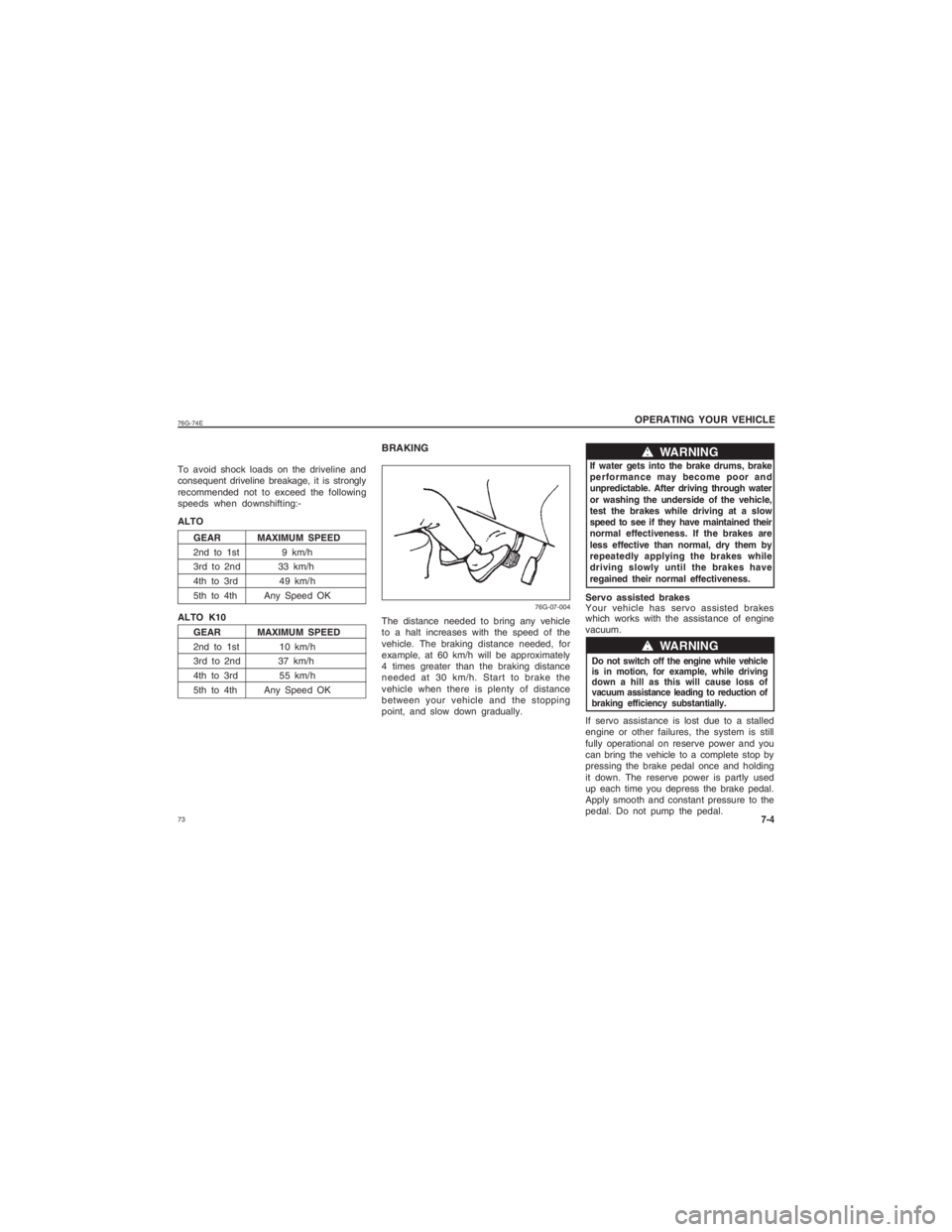
7376G-74E
7-4
OPERATING YOUR VEHICLE
BRAKINGww ww
w WARNING
The distance needed to bring any vehicle
to a halt increases with the speed of the
vehicle. The braking distance needed, for
example, at 60 km/h will be approximately
4 times greater than the braking distance
needed at 30 km/h. Start to brake the
vehicle when there is plenty of distance
between your vehicle and the stopping
point, and slow down gradually.
If water gets into the brake drums, brake
performance may become poor and
unpredictable. After driving through water
or washing the underside of the vehicle,
test the brakes while driving at a slow
speed to see if they have maintained their
normal effectiveness. If the brakes are
less effective than normal, dry them by
repeatedly applying the brakes while
driving slowly until the brakes have
regained their normal effectiveness.Servo assisted brakes
Your vehicle has servo assisted brakes
which works with the assistance of engine
vacuum.Do not switch off the engine while vehicle
is in motion, for example, while driving
down a hill as this will cause loss of
vacuum assistance leading to reduction of
braking efficiency substantially.If servo assistance is lost due to a stalled
engine or other failures, the system is still
fully operational on reserve power and you
can bring the vehicle to a complete stop by
pressing the brake pedal once and holding
it down. The reserve power is partly used
up each time you depress the brake pedal.
Apply smooth and constant pressure to the
pedal. Do not pump the pedal.
ww ww
w WARNING
76G-07-004
To avoid shock loads on the driveline and
consequent driveline breakage, it is strongly
recommended not to exceed the following
speeds when downshifting:-
GEAR MAXIMUM SPEED
2nd to 1st 9 km/h
3rd to 2nd 33 km/h
4th to 3rd 49 km/h
5th to 4th Any Speed OK
ALTO
ALTO K10
GEAR MAXIMUM SPEED
2nd to 1st 10 km/h
3rd to 2nd 37 km/h
4th to 3rd 55 km/h
5th to 4th Any Speed OK